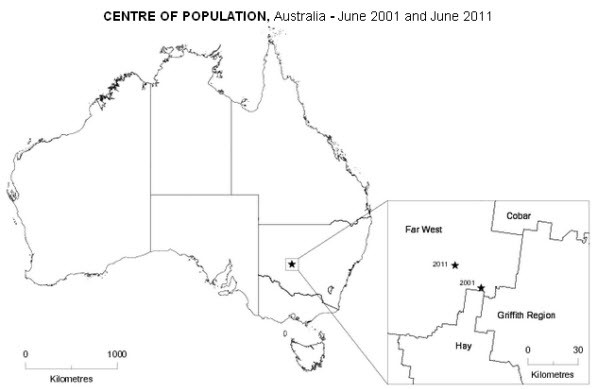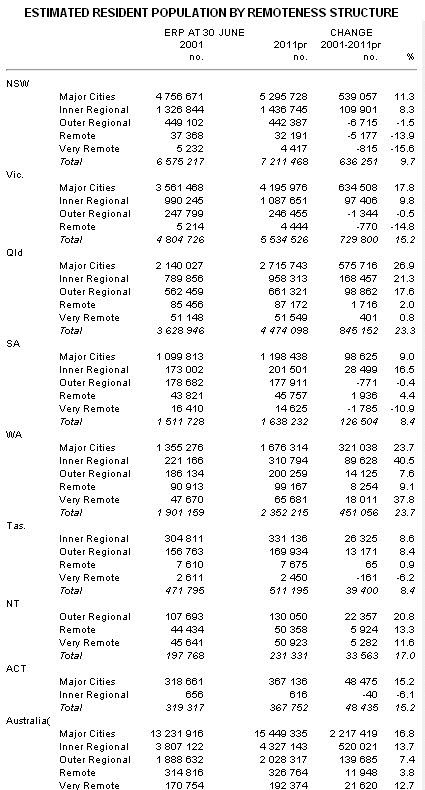Worrying about Asia. Perhaps the really worrying economic indicators for Australia are not those coming from far away Europe but those closer to home in Asia. Overnight Taiwan reported that its economy contracted 0.16% in the three months to the end of June, as the global slowdown weighed on exports. The country’s statistics agency cut its forecast for full year growth to 2.08% down from 3.03%.
Last week was the news that South Korea’s economic growth slowed between April and June, coming in at 0.4%, down from 0.9% in the first quarter.
Moving west and north. Australia’s centre of population at June 2011 was 39 kilometres east of the small service town of Ivanhoe, in western New South Wales. While this reflects the concentration of population in south-east Australia, the centre of population as measured by the Australian Bureau of Statistics moved 21 kilometres north-west in the ten years from 2001 to 2011. This shift reflects strong population growth in Queensland and Western Australia over this period.

The trend towards inner city living continues. As at June 2011, 69% of the population resided in Australia’s major cities. In comparison, just 2.3% lived in remote or very remote Australia. Major cities were the fastest-growing areas in Australia, up 17% in the ten years to June 2011. The remaining areas grew slower than Australia as a whole (15%), with remote areas growing at the slowest rate (3.8%).

Forget the s-x appeal. There’s bound to be an Australian star or two emerge from these Olympic Games but will the winner’s fame translate into fortune? Not if, according to some United States marketing research, they are women. And the fault will not lie with the talent but with the way they are used.
An upcoming article in the Journal of Brand Strategy by John Antil and Matthew Robinson suggests advertisers’ tactics are creating a cycle of failure for female athlete endorsers. According to Antil, the way female athletes are being used as endorsers negatively impacts their effectiveness and reduces wider opportunities for other female athletes. He points to advertisers’ focus on youth and s-x appeal, rather than other defining characteristics, including athletic ability:
Research shows women now purchase or influence 85 percent of all brand purchases. Likability and similarity play key roles in the effectiveness of a celebrity endorsement. Marketers seem to be ignoring both when it comes to female athletes.
Researchers found when the endorser was much younger than the targeted consumer, the large difference in age made it difficult for female consumers to relate to them. Consequently, the credibility of the young endorser and the product promoted suffered.
When s-x appeal was highlighted, consumers responded negatively, especially when comparing themselves to the spokesperson. The studies’ authors say highlighting the similarities between the endorser and the targeted consumer could be a more effective strategy.
Some news and views noted along the way
- The Euromess continues — the Eurozone will still be fundamentally hobbled by a devotion to re-balancing via austerity-driven internal devaluation.
- ECB on course to act strongly or disappoint mightily.
- Dissent grows among the voters of Europe — The eurozone’s political leaders are grappling with this crisis without any democratic mandate to shore them up.
- The unwritten rules of French waiters to get a bigger tip.







Crikey is committed to hosting lively discussions. Help us keep the conversation useful, interesting and welcoming. We aim to publish comments quickly in the interest of promoting robust conversation, but we’re a small team and we deploy filters to protect against legal risk. Occasionally your comment may be held up while we review, but we’re working as fast as we can to keep the conversation rolling.
The Crikey comment section is members-only content. Please subscribe to leave a comment.
The Crikey comment section is members-only content. Please login to leave a comment.